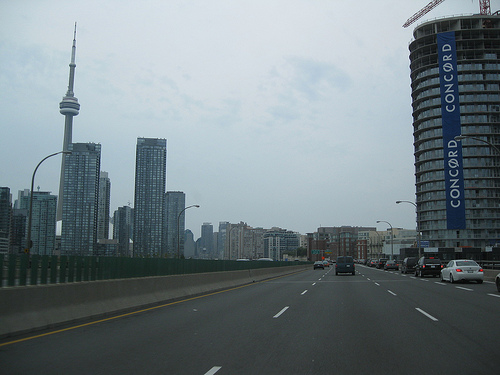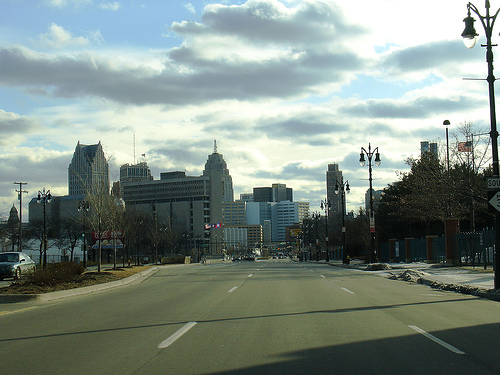The 10 most useless freeways in North America
An updated list of the nation’s most teardown-worthy highways is the highlight of the recently released report, Freeways Without Futures, compiled by the Congress for the New Urbanism, a nonprofit which works for “walkable, mixed-use neighborhood development, sustainable communities and healthier living conditions.”
CNU is the “hub” of the freeway removal movement, having formed a national panel of experts to discuss freeway teardown plans, collecting freeway data, and issuing public surveys on the movement to replace old urban highways with community-friendly street grids and better transit options.

The Gardiner Expressway turned some of Toronto’s most valuable real estate into a mere transport corridor, making it a prime candidate for retirement. From Dougtone.
“Streets should add value to the places they serve,” reads the CNU report. Streets are multi-purpose, serving communities, commerce, and pedestrians just as much as vehicles, argues the advocacy group. Yet freeways that have outgrown their purpose inhibit other transportation options, only serve vehicles, and, are by their nature “disconnected from their adjacent surroundings.”
But what’s the solution? CNU promotes the replacement of urban highways with boulevards, avenues, and surface streets as the most sustainable and cost-effective alternative. America’s infrastructure budget problems are already well-chronicled. Without funds to adequately replace aging highways, argues CNU, cheaper options — namely improved transit systems and connected street grids — are on the minds of politicians and civilians alike.
Freeway removal campaigns are only successful, argues CNU, if heralded by vigorous political and community support, long-term planning, and a changed focus: “a vision for the urbanized environment that is not dictated solely by the fast movement of motor vehicles.”
In the 2014 Freeways Without Futures Report, CNU provides an unranked list of North America’s current best freeway candidates for removal. The list is based on a range of considerations, including: potential for redevelopment; cost-savings potential; infrastructure design and age; capability of improving “overall mobility and local access;” existing ongoing infrastructure plans; and community backing.
The 2014 candidates, in no particular order, are:
- I-10/Claiborne Overpass, New Orleans
- Route 5/Skyway, Buffalo
- I-81, Syracuse
- Gardiner Expressway, Toronto
- I-490/Inner Loop, Rochester
- I-70, St. Louis
- I-280, San Francisco
- I-375, Detroit
- Terminal Island Freeway, Long Beach
- Aetna Viaduct, Hartford
Also included on the list are five other notable freeway-removal campaigns, which include: I-345, Dallas; I-895/ Sheridan Expressway, New York City (Bronx); SR-710 Extension, Alhambra & Pasadena; NYS Route 198/Scajaquada Expressway, Buffalo; and Robert Moses Parkway, Niagara Falls.
Most of the freeways making the list were constructed in the 1950s and 1960s, and in the zeal to connect suburb dwellers with urban jobs, these criss-crossed with seemingly wild abandon through neighborhoods with little thought of the consequence for surrounding communities. Today, these rapidly aging roads are prime candidates for removal.
Take the Aetna Viaduct, in Hartford, Connecticut: finished in 1965, the viaduct damaged historic neighborhoods and architecture, and broke the “walkable connections” between public spaces and communities. Even today, the viaduct dominates the landscape and prevents pedestrians from using the space below it, which is reserved for parking.

Detroit’s I-375, only a hair over a mile long, eats maintenance dollars in a city that’s penny-pinching everywhere else. From Gab482.
Then there’s the I-70 in St. Louis, which in 1964 separated the city from its riverfront and from the landmark Gateway Arch; the I-490/Inner Loop in Rochester, NY, which was built in the 1950s when the city had more than 100,000 residents than it does today; or the Gardiner Expressway in Toronto, which separates the city from its waterfront, and runs approximately $10 million in repair costs yearly.
Live near one of these removal candidates? Get involved with a community campaign. Community support for the highway-removal campaign is key, suggests CNU. Political and local advocates have the potential to help change “urban freeways and their adjacent corridors… from broken liabilities and legacy’s of dated thinking into assets that support vibrant, valuable places.”
Category: #Roadfix, Humor Traffic Signs, Infrastructure
















